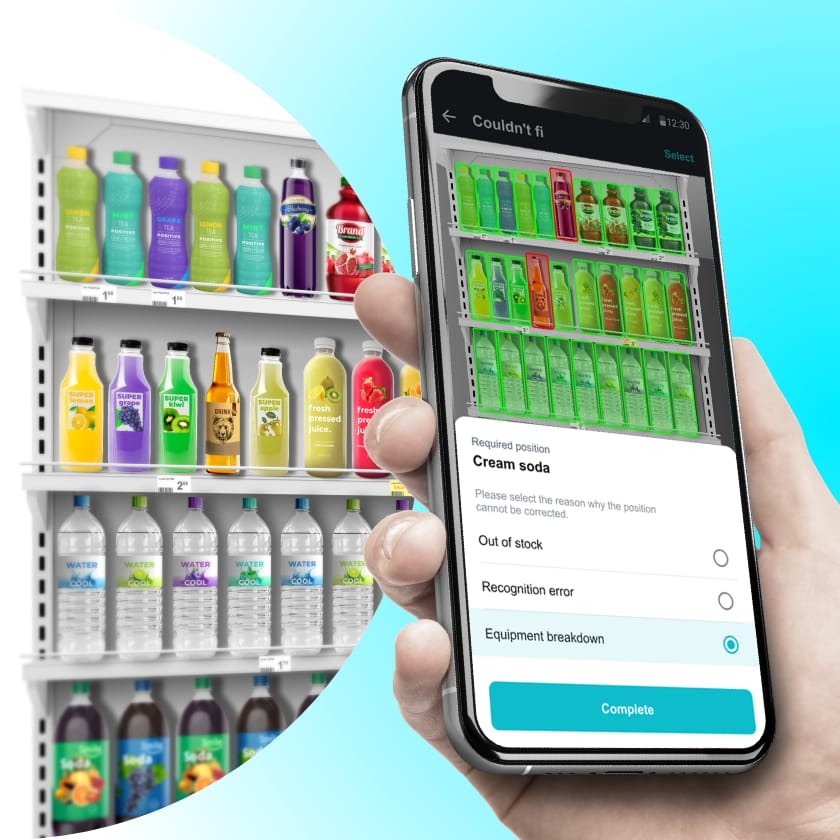Table of Сontents
The Importance of Shelf Monitoring and the Current Monitoring Practices
Product monitoring facilitates effective management of shelf positioning, product availability, and competitor actions. It helps identify problematic areas, such as competitors in advantageous positions, stockouts, etc. Furthermore, continual monitoring makes it easier to evaluate merchandising operations, like the placement of point-of-sale items and promotional displays.
FMCG firms deploy dedicated teams to visit stores regularly for product checks, either independently or with the support of merchandising companies. These teams evaluate the product representation on the shelves using reports, photographs, and physical inspections to take appropriate action as necessary.
Hence, companies can fine-tune their products, offer exceptional experiences, and keep a competitive edge by utilizing advanced monitoring technologies. These technologies may help them use customer feedback. Continual product review and optimization help companies offer meaningful experiences to customers and establish brand loyalty.
Challenges in Shelf Monitoring

There are many challenges in product monitoring which make it a complicated affair. Some of these include:
Paper-Based Manual Processes
Merchandising audits involve numerous moving elements and retail management. Completing all these activities may take time and significant effort. Furthermore, store owners have little choice but to rely on manual methods.
However, human error is always possible, which results in mistakes and inaccuracies. The long-term consequences of these human errors can vary, but they devastate the retail industry in the long run. A single management problem can cost a company its reputation or hundreds of thousands of dollars.
Failure to Determine Work Completion
Manual processes may appear to be a good idea initially, but they are often more difficult to oversee and manage. They are not only time-consuming but can also take longer if a mistake is made. The floor managers can’t keep track of everything.
They may only sometimes be aware of when merchandisers visit the store. Furthermore, they will not have a specific date or images for the essential records. Because of these factors, managing the store’s staff has become challenging.
Inadequate Real-Time Data and Insights
Without automation, analytical reports may contain obsolete or incomplete information. For example, after completing retail shop audits, supervisors may obtain numerous images of the shelves from merchandisers. The manager only has time to go through some of these photographs. They are forced to write reports based on their subjective vision. This data needs to be more comprehensive to derive insights from the reports and develop future initiatives. As a result, CEOs need to make better managerial decisions.
Requirements for Shelf Monitoring Solutions

To minimize the mentioned challenges, companies are now focusing on industry-specific solutions that automate shelf monitoring.
Critical requirements for these solutions include:
Accuracy of Recognition
A critical requirement for shelf monitoring solutions is the capacity to accurately recognize and identify specific products or variations within a product line. This includes advanced image recognition or other technologies to ensure accurate shelf monitoring.
Speed and Efficiency
A shelf monitoring solution must be efficient and operate optimally to accommodate businesses’ fast-paced nature. Rapid data processing allows companies to quickly identify anomalies and take prompt action to mitigate such issues.
Flexibility and Adaptability
The latest shelf monitoring solutions are adaptable and flexible to meet different product types and industries’ unique needs. They should be able to accommodate various monitoring parameters, such as shelf share, out-of-stock, employees’ feedback, etc.
Integration with Other Systems
Integration capabilities are essential for seamless data flow and collaboration across different departments and systems. To streamline workflows, a shelf monitoring solution should integrate with existing customer relationship management (CRM), enterprise resource planning (ERP) systems, inventory management tools, software, and other relevant platforms.
Analytical Capabilities
Advanced analytical skills are adequate for accurate shelf monitoring solutions. These systems must analyze vast amounts of data and provide management with detailed analytics. Decision-makers can use data visualization tools and bespoke dashboards to evaluate monitoring data to support strategic objectives and continuous product development.
Mobile Compatibility
With increased workforce mobility, shelf monitoring systems should allow mobile access. Users can use mobile applications or flexible web interfaces to monitor product performance, receive real-time notifications, and access crucial data from anywhere, enhancing operational efficiency and facilitating quick decision-making.
By meeting these requirements, shelf monitoring solutions empower companies to streamline their monitoring processes, ensure accurate and efficient tracking, and derive valuable insights to optimize product performance, customer satisfaction, and overall business success.
Goods Checker Hi-Tech Solution for Shelf Monitoring

Many shelf monitoring solutions are available on the market, but none works as efficiently as Goods Checker. This AI-powered tool is engineered for FMCG firms to guarantee accurate shelf monitoring and planogram compliance. Goods Checker leverages computer vision technologies to recognize products and assess their shelf placement.
Merchandisers photograph store shelves, and Goods Checker analyzes the photos automatically, determining the appropriateness of the product arrangement and any missing products. You get real-time analytics, speedy shop audits, and accurate analysis, with an accuracy rate of over 95%. In addition, it can handle a significant volume of photos daily. Integration with CRM systems offers extensive insights across all KPIs.
How Goods Checker Works in Practice

Alfa-Distribution, an established distribution and transportation company, is a multi-brand distributor of confectionery, chocolate, coffee, tea, spices, and other food products. Good Checkers’ items checker solution helped them identify inappropriate presentation of things in the retail chain.
In addition, company executives obtained a transparent display control system and increased interaction with the network. The rapid speed of Goods Checker operation reduced the time required for field audits in stores as one image gets processed in as little as 30 seconds. The final recognition accuracy is 90%.
Goods Checker is a SaaS application that automates all stages of merchandising for FMCG manufacturers and distributors. It is a reliable name in product monitoring solutions. Contact us today to find out more.




